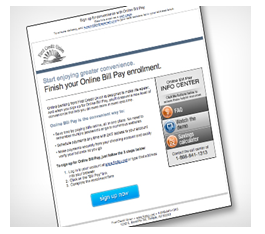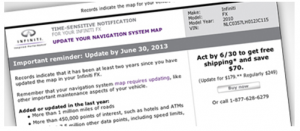

J&C Blog
Find all the latest marketing trends on the J&C Blog.

Find all the latest marketing trends on the J&C Blog.
In most endeavors, the difference between success and failure often comes down to the little things. Successful email marketing campaigns are no different. Strong email campaigns rely on trial and error. They count on past performance to point the way for improvements. Successful email marketing campaigns also leverage best practices and insights from campaigns that came before them.
The following blog examines real-world examples that demonstrate how paying attention to the little things can make a big difference in email marketing. We will explore 8 elements that make up the anatomy of a successful email marketing campaign.
1. Think of Core Email Content as a Conduit
When it comes to email readership, few recipients ever make it past the subject line. And even fewer find the content compelling enough to click through. The simple fact is consumers digest email content differently from other media.
We recently conducted a test to determine whether a full list of instructions detailing a complex process was more helpful than edited, pared-down instructions. The results of paring down instructions were impressive. Instructions that were simplified from 10 steps to 4 increased click-through by 30%.
Unlike direct mail and web pages, where it’s a best practice to give consumers complete information to make fully informed decisions, email content must be more tightly packaged. Think of email content as a conduit that leads to richer, more robust information. The key is to simplify content into easily digestible sound bites and then tease readers to learn more by clicking.
2. Link to Informational Resources
 Successful email marketing campaigns embrace resource links as a way to balance the need to simplify email content with the inherent requisite of informing customers. Keep in mind, successful campaigns don’t arbitrarily link to dozens of outlets. Resource links should always be packaged in a way that complements the email campaign strategy, core content and design aesthetic.
Successful email marketing campaigns embrace resource links as a way to balance the need to simplify email content with the inherent requisite of informing customers. Keep in mind, successful campaigns don’t arbitrarily link to dozens of outlets. Resource links should always be packaged in a way that complements the email campaign strategy, core content and design aesthetic.
In a specific email test where we pitted info center links against instructional copy, there was an impressive finding. Recipients were almost 30% more engaged in the info center email and 10% more likely to transact. The key insight is that customers will actively reach out for the information they need to make a decision. Customers don’t need to be given all the details about a product or service within the email itself.
3. Use a Single-Focused Call-to-Action (Multiple Times)
A fundamental truth in all response marketing is that featuring two or more different calls-to-action significantly diminishes response. Multiple calls-to-action often confuse customers and lead to lower response rates. That’s why it’s critical to keep email communications single-focused. Whether the aim is to entice customers to try a new product or use a service more often, email campaigns should focus on a single objective and one specific action.
This is not to say that there should only be one call-to-action within an email. As long as there’s a single focus, successful email marketing campaign best practices suggest a call-to-action be included at least three times within an email.
4. Ensure Mobile Optimization
Adobe reports that 79% of users use their smartphones for reading email, a higher percentage than those who use them for making calls1. There’s a big difference in the way consumers interact with smartphones and PCs, and marketers need to take notice. Ensuring emails are optimized across multiple devices and viewing screens is a priority.
There are a number of considerations when optimizing emails for mobile. First, ensure emails include response buttons that are large enough to tap comfortably on the smallest smartphone. Think of these as touch targets. Second, use standard call-to-action text links throughout the content to ensure recipients can respond throughout the email. Third, ensure the first call-to-action appears as a button on the first screen. Recipients shouldn’t need to scroll to take action. Fourth, consider using icons to engage and link to primary content. Successful email marketing campaigns typically use visual helpers to drive engagement and increase response.
Check out Responsive Design Drives the Future of Mobile to learn more on mobile optimization and successful email marketing campaigns.
5. Employ Personalization
 With the advent of more customized inboxes, content-tailored websites and personalized landing pages, it’s not surprising that customers demand more personal communications from marketers. According to MarketingSherpa, 69% of people state they would exchange their personal information for better, more personalized service.
With the advent of more customized inboxes, content-tailored websites and personalized landing pages, it’s not surprising that customers demand more personal communications from marketers. According to MarketingSherpa, 69% of people state they would exchange their personal information for better, more personalized service.
To prove how dramatically personalization can lift response, we recently conducted a test with an email containing customer vehicle information, including make, model, VIN number and year against an email without this information. It’s not surprising that the personalized email performed better. What is surprising is how much better it performed. The personalized email drove almost a 40% higher click-through than the general email.
6. Compartmentalize the Design
One of the easiest ways to critique a successful email is to see if it’s scannable. If an email takes longer than four seconds to comprehend, it’s probably too long and in dire need of editing.
In order to deliver a concise message, the body of an email should be abbreviated, make use of bulleted copy points and link to more robust content wherever applicable. The key is to compartmentalize the design. This is often done modularly by setting core content, secondary informational links and the primary call-to-action.
When compartmentalized properly, recipients should be able to effortlessly scan content, immediately understand what’s being asked and be able to quickly find a desired path to action. Compartmentalized emails come in all shapes and sizes. The most successful email marketing campaigns don’t overwhelm the recipient and allow them to quickly get through what’s being offered.
7. Leverage Subject Lines
Email subject lines are often overlooked by marketers. And there are some fairly standard reasons as to why. The subject line is almost always the last part of an email to be developed. As such, it usually isn’t given the attention it deserves. Many marketers simply restate the offer or call-to-action in the subject line and hope for the best.
 But the most effective subject lines do more. Successful subject lines leverage a key audience motivator and tease the audience inside. This isn’t to say subject lines should be deceptive. Rather, successful email marketing campaigns embrace subject lines that are suggestive. They tease the recipient on what can be gained by opening the email.
But the most effective subject lines do more. Successful subject lines leverage a key audience motivator and tease the audience inside. This isn’t to say subject lines should be deceptive. Rather, successful email marketing campaigns embrace subject lines that are suggestive. They tease the recipient on what can be gained by opening the email.
Another subject line best practice is to incorporate your brand or business name. It’s often not enough to rely on the friendly from to identify yourself to the consumer. We recently conducted subject line testing and found that subject lines that include a brand or company name lift open rates by 10 to 30 percent.
8. Develop Complementary Resources
One of the keys to a successful email marketing campaign is to ensure informational content and resources exist before the campaign goes to market. This sounds like a no-brainer. But far too many marketers scramble to develop informational resources at the last minute.
Linking to incomplete, disjointed and/or third-party information can hurt credibility and response. It also runs the risk of leaving customers unprepared to make informed decisions about your product or service. Allowing time to prepare complementary resources is a key to a successful email marketing campaign.
As email marketing continues to evolve, it’s important to keep up with the latest.
Sources:
1. Adobe, 2013 Digital Publishing Report: Retail Apps & Buying Habits
Topics: Email Marketing
303 E Wacker Drive, Suite 2030
Chicago, IL 60601
Phone: 312-894-3000
Fax: 312-894-3005